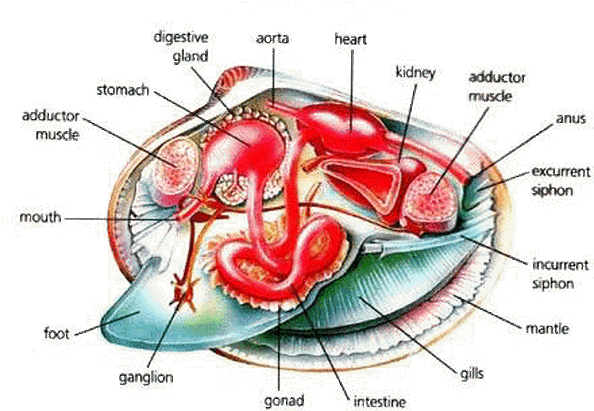
Noah Golestani, Alec Wilson, Nikolai Bottitta, Prakhar Pandey, Thejas Kadur
Mollusca
Mollusks have distinct respiratory and circulatory systems, which allows for an improved capacity for oxygen uptake and distribution. Mollusks can be found living both on land and in water. Those living on land respire using a mantle cavity with a large surface area lined with blood vessels. The mantle cavity is a central feature of molluscan biology. This cavity is formed by the mantle skirt, a double fold of mantle which encloses a water space. This space contains the mollusc's gills, anus, osphradium, nephridiopores, and gonopores. The mantle cavity functions as a respiratory chamber in most molluscs. The mantle cavity encloses a large amount of space. It is lined with epidermis, and is exposed to either water or air. The cavity was at the rear in the earliest mollusks, but its position now varies from group to group. Oxygen and carbon dioxide diffuse through the moist skin of these land-dwelling mollusks. Mollusks which live in the water typically breathe using gills inside their mantle cavity. They use tubes called siphons to move water in and out of their bodies (Mollusca).
Mollusca are known to be relatively evolved when compared to other phyla; however, when compared to the phylum arthropoda, the mollusca phylum is about equally evolved, seeing as there are many organisms that are more evolved comparatively to a certain organisms in the other phylum, thus making it difficult as the more “evolved” phylum switches on a case to case basis. However, when compared to other previous phylums the Mollusca phylum is more evolved due to the fact that they have two independent systems for both circulation and respiration, unlike all of the other aforementioned phyla, excluding that of Arthropods, which begins the distinction in the specialization of systems, between circulatory and respiratory system with the inclusion of tracheae, among other specialized systems.

An internal view of mollusk anatomy which includes organs such as the gills and heart

A deadly blue ringed octopus - a wonderful example of a mollusk

Contrary to popular belief, octopi are amazing clarinet players.

The mantle cavity is where the majority of respiration occurs in mollusks

The two long black bits on either side of the main body of innards are the gills of the squid. They work much in the same way that those of the crayfish do. If you follow their connections carefully, you will arrive at one of the squids many hearts.

Contrary to popular belief, octopi are amazing clarinet players.
